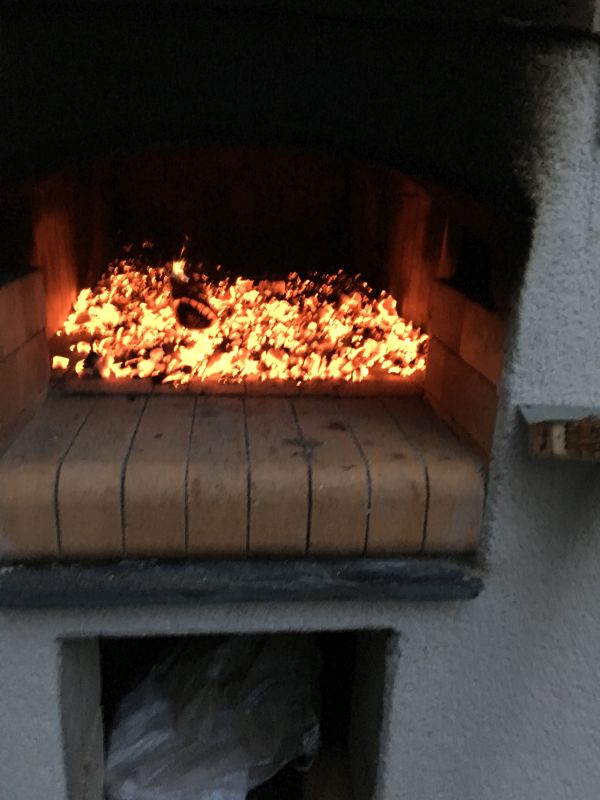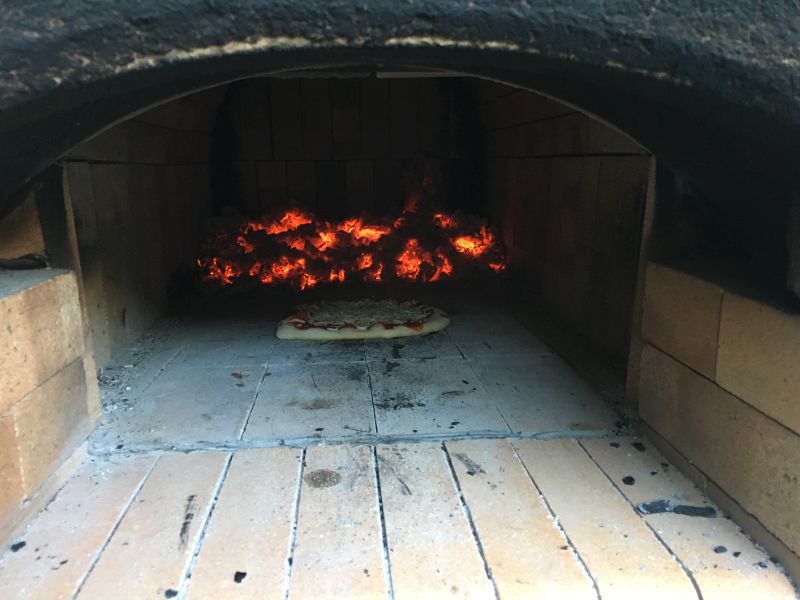|
|
Post by albacore on Oct 11, 2017 21:38:07 GMT
My oven lights very easily and once the fire is going it will eat wood as fast as I can feed it.
Is it better to keep feeding it with lots of wood and eventually when I think it is hot enough, maybe after an hour, then to just feed it a log or two now and then to equalise and maintain temperature until ready to cook pizza?
Or is it better to spread the wood feeding out, ie keep feeding it only moderate quantities but over a longer period of time until it is ready?
Also, during this heating up phase, it seems to me that an awful lot of heat must be going up the chimney. Wouldn't it be better to have an adjustable restrictor in the flue to slow down this heat loss?
Lance
|
|
|
|
Post by simonh on Oct 11, 2017 21:41:59 GMT
In for the updates on this as I am really interested in the answer
|
|
|
|
Post by crammy on Oct 12, 2017 11:47:58 GMT
Does the type of wood used effect this? i was going to order some kiln dried ash and oak for when my oven is finished ( well just useable for pizza until insulated) and was told it takes ages to burn. I did hear that damp or cheaper woods burn out quicker.
|
|
|
|
Post by simonh on Oct 12, 2017 12:05:59 GMT
Hardwood burns slower than softwood, kiln dried produces less smoke than non kiln dried
|
|
|
|
Post by albacore on Oct 12, 2017 12:29:10 GMT
Don't use damp wood. It will give off loads of smoke and may spit back in your face.
Kiln dried oak and ash are the Rolls-Royces of WFO wood - great to use, give out lots of heat, but are pricey. I tend to use them once the fire is going well to give it a bit of umph half an hour before pizza time.
Lance
|
|
|
|
Post by crammy on Oct 13, 2017 5:54:57 GMT
Don't use damp wood. It will give off loads of smoke and may spit back in your face. Kiln dried oak and ash are the Rolls-Royces of WFO wood - great to use, give out lots of heat, but are pricey. I tend to use them once the fire is going well to give it a bit of umph half an hour before pizza time. Lance what do you use albacore to get the fire going if you just use kiln dried half hour before cooking. I'm hoping to get mine finished this weekend, weather permitting. when i say finished i just mean the brick dome. i will still have to sort the outer arch, chimney and insulate it, but i just want to try it out. |
|
|
|
Post by simonh on Oct 13, 2017 9:38:40 GMT
I think what he means is that he just uses oak and ash half an hour before pizza time, the rest of it is just standard kiln dried hardwood.
I just use standard kiln dried hardwood, people do say that oak and ash impart extra flavour into the cooking but I have yet to try that out to compare.
you really want to be using hardwood that is either kiln dried or very properly seasoned so the moisture content is low, this burns better and gives out more heat for longer. Kiln dried is just a shortcut way to drive the moisture out,but obviously it cost more because it is an additional process.
when you are properly up and running you can use residual heat from the oven to assist in the drying of non kiln dried wood to achieve the same effect for less money.
|
|
|
|
Post by albacore on Oct 13, 2017 11:57:09 GMT
Yes, that's about right. My local wood supplier sells bags of mixed hard and softwood at a good price. Until recently this wasn't kiln dried, but they've recently started kiln drying it.
They also sell oak and ash mixed kiln dried. I think this is imported from Germany; it's good stuff, but twice the price.
So I start the fire with kindling and some axe split ordinary. Feed it with ordinary and then, as I stated, bung on some of the good stuff when the fire is near to pizza time.
Now that the ordinary is kiln dried, I don't need to use quite as much of the oak/ash.
PS, all you WFO experts, no one has answered my original queries yet!
Lance
|
|
|
|
Post by simonh on Oct 13, 2017 12:18:46 GMT
so during the heating phase I have my flue wide open to maximise airflow through the oven to get the burn going.
I have tried a couple of ways, one building a stack right to the roof to get a good load of heat right from the start, these seemed to produce lots of smoke and not a great deal of heat, so I then tried about half that and feeding more logs in every 30-40 minutes or so, this produced much less smoke and seemed likes more heat. I kept the fire over the cooking area and push it to the back about 30 minutes before I wanted to cook to allow the cooking floor to stablise. At this point I close the flue a bit to keep heat in and just have enough flame going to keep the top of the oven hot and feed in the occasional log to have a live flame.
there is an rate of heat that firebricks can absorb over time so putting too much heat in early is a waste of wood but I can't recall what that rate is, I always plan on about 2 hours or so from lighting to pushback and first cooking
|
|
|
|
Post by devontiger on Oct 13, 2017 14:23:56 GMT
Quote " Also, during this heating up phase, it seems to me that an awful lot of heat must be going up the chimney. Wouldn't it be better to have an adjustable restrictor in the flue to slow down this heat loss " Simple answer Yes. I have found it all to be trial & error. I normally light up with old wood, maybe soft wood bits of old clean pallet. Then when alight I spread the hardwood over this a wait about an hour for the temp to come up. I then push all the wood & embers toward the back, Or sides whatever is best for your oven. I have a restrictor in the flue just above the dome. If I close it too much, a bit of smoke will come out the door, so I just open it up a little.    |
|
|
|
Post by devontiger on Oct 13, 2017 14:26:54 GMT
The stack of wood logs you see will do best part of 3 burns, according to how many Pizzas I'm doing.
Its all well seasoned as its part of a load I got 18 month ago.
The yellow bag of bits will do 2 light ups.
|
|
|
|
Post by downunderdave on Oct 13, 2017 19:39:54 GMT
Quote " Also, during this heating up phase, it seems to me that an awful lot of heat must be going up the chimney. Wouldn't it be better to have an adjustable restrictor in the flue to slow down this heat loss " Simple answer Yes. I have found it all to be trial & error. I normally light up with old wood, maybe soft wood bits of old clean pallet. Then when alight I spread the hardwood over this a wait about an hour for the temp to come up. I then push all the wood & embers toward the back, Or sides whatever is best for your oven. I have a restrictor in the flue just above the dome. If I close it too much, a bit of smoke will come out the door, so I just open it up a little. For ovens with the flue in the centre of the dome(updraft) the flames will want to go straight to the flue pipe. They do require a damper and do require more fuel. The advantage is less smoke at start up. For ovens with the flue at the front (cross draft) all the flame remains inside the dome so there is far less heat loss, lower fuel consumption and no need for a damper. The downside is that you have a deeper entry to work past requiring tools with longer handles. On burning pallets, make 100% sure that they have not been treated. As most are designed for export they have been treated and create poisonous fumes. Safer not to use them. For cooking pizza always maintain a fire (usually on the side as it’s easier to maintain) during cooking. It acts a an oven light and keeps the dome temp up.    |
|
|
|
Post by simonh on Oct 16, 2017 15:44:35 GMT
his is typically what my fire looks like shortly before I start cooking  and when I am cooking  |
|
|
|
Post by downunderdave on Oct 16, 2017 19:43:54 GMT
After the fire has been going for around 45 mins you should try to fill the whole chamber with flame. Depending on dryness of the oven, wood quality and thickness of walls and floor the oven will then take around another 45 mins to get to pizza temp. When cooking pizza the flame should also be maintained on the side of the oven.
|
|
|
|
Post by albacore on Oct 16, 2017 20:13:39 GMT
Dave,
so after you have filled the chamber with flame (after the first 45 mins), do you then keep feeding the whole area with more wood for the next 45 mins?
That does sound like a lot of wood.
Lance
|
|